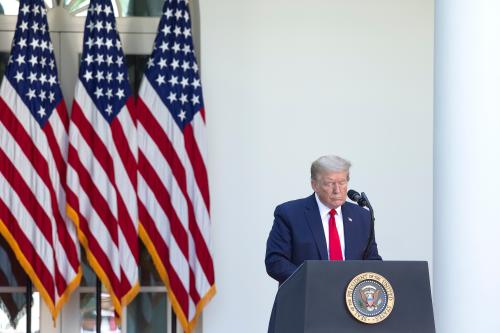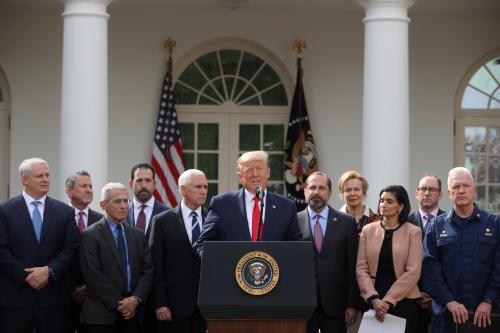As the Republican National Convention opens this week, President Donald Trump is in a tough position. He is trailing his opponent, former Vice President Joe Biden, by 7.6% in the RealClearPolitics average of polls and by 8.7% in the fivethirtyeight.com average. With the exception of North Carolina, he trails Biden in each of the 2016 swing states as well as in Arizona, which he carried by 3.6% four years ago. Ohio and Iowa, which he carried by large margins in 2016, are in play this time, as are Georgia and Texas, long safe in the Republican column. There isn’t much doubt that if the election were held today Trump would lose and might well take down the Republican Senate with him.
So, all eyes will be on the Republicans’ convention this week to see if Trump can turn the tide and have a fighting chance of winning the Electoral College, even if he can’t win the popular vote.
His strategy so far has been to expand support from his mobilized base. There is some basis for this. For instance, according to a story in Saturday’s Wall Street Journal (citing a study by Brookings’ Bill Frey), 68% of the non-voters in Wisconsin are whites without college degrees, as are 62% in Michigan and Pennsylvania. If Trump could get turnout in this demographic back up to the level Bush achieved in 2004, he could win all three states. (In 2004, as opposed to 2016 white working-class turnout was 7 percentage points higher in Wisconsin, 5 .7 percentage points higher in Michigan and 2.7 percentage points higher in Pennsylvania.)
Trump’s relentless focus on working class white men has been a feature of his entire presidency, and while it may have solidified his base, it has cost him support among college educated men and women, working class white women, and Asians, now the most rapidly growing group category of the US population and electorate. He’s not going to make much progress among Black voters, especially Black women. He’s weaker among seniors than he was four years ago, and young adults currently oppose him by a margin of 2-1. The only bright spot for him: there’s no evidence that his stands on immigration and cultural issues have cost him any of the Latino support he won in 2016. Although according to CNN exit polls, Mr. Trump only won 28% of Latinos four years ago.
As we watch this week we’ll be asking: what does Trump have to do to get back into the game?
Embrace a comprehensive national-level strategy on the coronavirus pandemic. If the pandemic is going to be the central issue in the election, Trump needs to change the narrative on it. So far, his attempts to lead, starting with his series of disastrous daily press conferences in the spring, showed his weaknesses as a leader—not his strength—as demonstrated through public polling on Americans’ confidence in his handling the crisis. As he has flailed, he has also resisted an organized national-level strategy, the only course of action with any prospect of success.
Depict Biden’s economic program as a threat to economic growth and the middle class. At the start of this election year, Trump’s advantage was the strong economy and low unemployment. COVID-19 has all but wiped out his advantage on the economy and if it continues to shrink, he can’t win. He has no choice but to depict Biden’s economic program as a threat to future economic growth and the middle class. In so doing, he will no doubt try to scare Americans by describing and/or hyperbolizing levels of taxation proposed by the left wing of the Democratic party.
Address the issue of character head on. Throughout Trump’s presidency his behavior in office; the constant tweeting, the belittling of his opponents and his overall non-presidential behavior has bothered even his Republican supporters. The issue of his character was front and center at the Democratic convention. Somehow Trump needs to take the edge off the character issue. He could admit that he’s a little rough around the edges and try to turn his faults into virtues by arguing that only his bulldozer tactics can work against entrenched elite resistance. But this would require a level of introspection and humility he has never shown before.
Make the election about Biden and the Democrats. This is very difficult to do when you are an unpopular incumbent, especially when you wasted precious spring and summer months on scattershot attacks without a settled strategy. But Trump has been trying to assault Biden’s character, painting him as vacillating, lacking principles and commitments, and too weak to stand up to the left. He could also assault Biden’s record on foreign policy by quoting former Defense Secretary Robert Gates who claimed that he has been wrong about every major foreign policy issue in the past 40 years.
And finally, he will trot out that old favorite—the culture wars—immigration, religion, transgender rights, guns, and abortion, among other hot button issues. He could try to tag Biden with defunding the police and make him deny it, and he could argue that Democrats’ charges of America’s “systemic racism” reveal a lack of love for their country. Don’t be surprised if he reaches back to 1984 to charge that Democrats always “blame America first.”
Try to convince America that it is 1968. In the lead up to his convention, Trump has been channeling former President Richard Nixon, circa 1968, running as the defender of “law and order” against the champions of disorder, rioting in the streets. He will portray Democrats as weak on crime, making excuses for rioters and murderers, and he will depict America’s cities as out of control and burning.
Scare suburban women. The threat that urban disorder will spread to the suburbs and that Democrats will destroy property values with low-income housing represents Trump’s strategy for wooing the suburban women who deserted Republicans in the 2018 midterms and who are abandoning him in droves this year. Whether suburban women will regard these possibilities as graver threats to their interests than the continuation of Trump’s presidency and the policies that made them turn away from Republicans two years ago remains to be seen.
Each of these strategies has its downsides: it is not 1968, women voters may be too disgusted to come back, and Americans have moved left on many cultural issues. After Biden’s forcefully delivered acceptance speech, it will be harder to convince America that he’s too old or too weak for the job, let alone mentally incapable of performing it. If Trump hasn’t been able to put together a national coronavirus plan so far, it may be too late to devise and implement one now. And economic growth is projected to be weak in the coming months, especially in the absence of more fiscal stimulus.
But Trump’s biggest problem might be that he is so sure of his own “stable genius” that he will never take anyone’s advice but his own. We saw the electoral consequences of this obstinance in 2018, when Republican leaders begged him to campaign on the economy, but his insistence on focusing on immigration contributed to House Republicans’ being swept from power. If Donald Trump manages to pull off one of the greatest political recoveries in modern presidential politics, it won’t be his political advisors and ad makers who made it happen. It will be entirely attributable to his own gut instincts, his unique read of the American political landscape, and the energy he draws from his deep fear of being a loser.








Commentary
Can the Republican Convention turn things around for Trump?
August 23, 2020